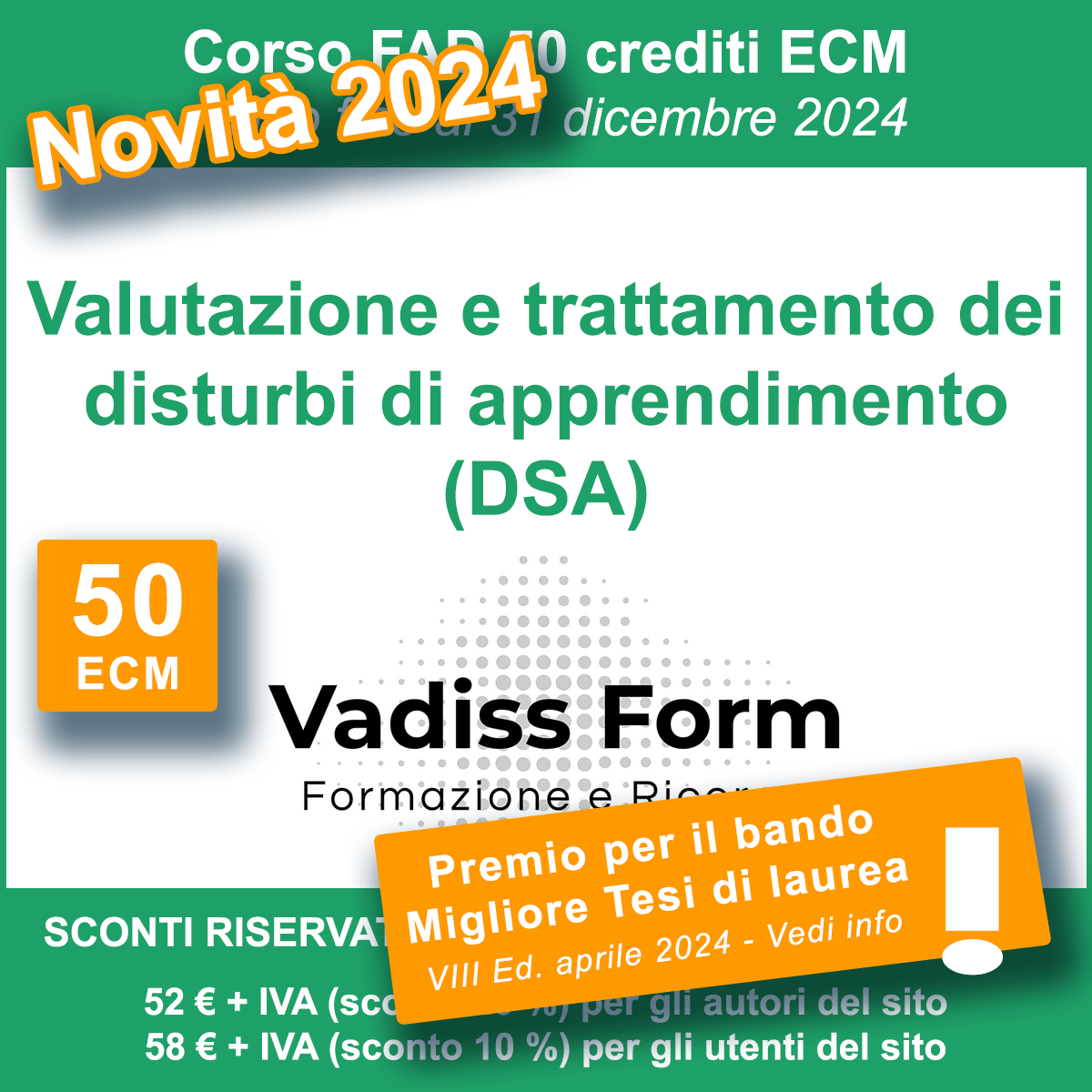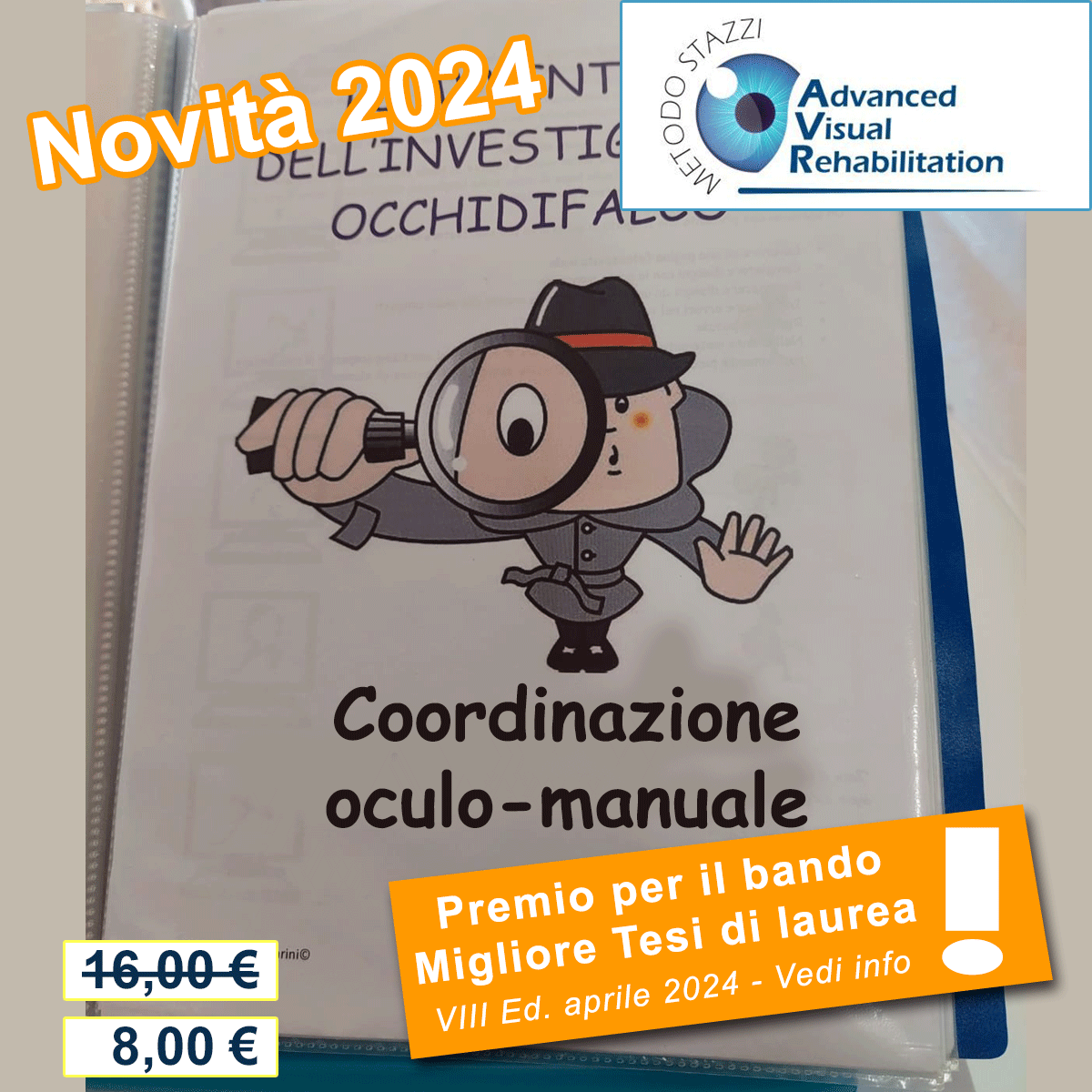BIBLIOGRAFIA e SITOGRAFIA - Le Funzioni Esecutive: l’utilizzo della Terapia Neuropsicomotoria in un gruppo di bambini con ADHD
Teresa Sferrazza
Visite: 3033
BIBLIOGRAFIA
- Alloway T.P., Gathercole S.E., Willis C. e Adams A.M. (2004), A structural analysis of working memory and related cognitive skills in young children, “Journale of experimental child psychology”, vol. 87, n. 2, pp. 85-106.
- American Psychiatric Association (2002), DSM-IV-TR, Manuale diagnostico e statistico dei disturbi mentali, Text Revision, Milano, Masson.
- Anderson P. (2002). Assessment and development of executive function during childhood, Child Neuropsychology, vol. 8, n. 2, pp- 71-82.
- Baddeley A.D. e Hitch G.J. (1974), Working memory. In G.A. Bower (a cura di), The psychology of learning and motivation: Advanes in research and theory, New York, Accademic Press, vol. 8, pp.47-89.
- Baddeley A.D. (1986), Working memory, Oxford, Oxford University Press.
- Baddeley, A. D. (1990). Human Memory. Theory and Practice. Hove, Erlbaum.
- Baddley A. (1992), La memoria umana. Teoria e Pratica, Bologna, Il Mulino.
- Baddeley A.D. e Hitch G.J.(1994), Developmental in the concept of working memory, “Neuropsychology”, vol. 8, n. 4, pp. 485.
- Baddeley, A. D. (1996). Exploring the central executive. Quarterly Journal of Experimental Psychology, 49A, 5-28.
- Baddeley A. D. (2000). The episodic buffer: A new component of working memory? Trends in Cognitive Sciences, vol. 4, pp. 417-423.
- Barkley R.A. (1997), Behavioral inhibition, sustained attention, and executive functions: Constructing a unifying theory of ADHD, “Psychology Bullettin”, vol. 8, pp.216-226
- Barkley R.A. (1997), ADHD and the nature of self-control, New York, Guilfors Press.
- Berchicci M. e Bertollo M. (2009), Il contributo psicomotorio nell’intervento multidisciplinare in un bambino con ADHD, in “Psicomotricità”, vol. 13, n. 1.
- Booth J.N., Boyle J. e Kelly S. (2010), Do task male a difference? Accounting for heterogeneity of performance of children with reading difficulties on tasks of executive function: Findings from a meta-analysis, “British Journal of Developmental Psychology”, vol. 28, pp. 133-176.
- Cantagallo A., Spitoni G., Antonucci G. (a cura di, 2010). Le Funzioni Esecutive. Roma: Carocci.
- Castellanos F.X. (1997), Toward a pathophysiology of Attention-Deficit/Hyperactivity Disorder, “Clinical Pediatrics”, vol. 36, pp.381-393.
- Castellanos F.X., Sonuga-Barke E.J., Milham M.P. e Tannock R. (2006), Characteristic cognition in ADHD: Beyond axecutive dysfunction, “Trends in cognitive sciences”, vol. 10, n. 3, pp. 117-123.
- Cornoldi C., Mazzocchi G.M., Belotti M., Caroli M.G., Meo T. e Braga C. (2001), Working memory interference control deficit in children referred by teachers for ADHD symptoms, «Child. Neuropsychol.», vol. 7, n. 4, pp. 230-240.
- Cornoldi C, Meneghetti C., Moe A. e Zamperlin C. (2018), Processi cognitivi, motivazione e apprendimento.
- Craig F., Margari F., Legrottaglie A.R., Palumbi R., de Giambattista C. e Margari L. (2016), A review of executive function deficit in autism spectrum disorder and atention-deficit/hyperactivity disorder, “Neuropsychiatric Disease and Treatment”, vol. 12, pp. 1191-1202.
- Daffner K., Searl M. (2008), The Dysexecutive Syndromes, Handbook of Clinical Neurology, vol. 88, pp. 250-267.
- Damasio A.R. e Anderson S.W. (1993), The frontal lobes, “Clinical neuropsychology”, vol. 4, pp. 404-406.
- Daunhauer L.A., Fidler D.J., Hahn L., Elizabetj Will E., Lee N.R. e Hepburn S. (2014), Profiles of everyday executive functioning in young children with Down syndrome, “American Journal on Intellectual and Developmental Disabilities”, vol. 119, pp. 303-318.
- Davidson M.C., Amso D., Anderson L.C. e Diamond A. (2006), Development of cognitive control and executive functions from 4 to 13 years: Evidence from manilupations of memory, inhibition, and task switching, “Neuropsychologia”, vol. 44, n. 11, pp. 2037-2078.
- Devine R.T. e Huges C. (2014), Relations between false belief understanding and executive function in early childhooh: A meta-analysis, “Child Development”, vol. 56, pp. 1777-1794.
- Diamond A. (2012), Activities and programs that improve children’s executive functions, “Current Directions in Psychological Science”, vol. 21, pp.335-341.
- Diamond A. (2013), Executive Functions, “Annual Review of Psychology”, vol. 64, pp. 135-168.
- Dickstein S.G., Bannon K., Castellanos F.X. e Milham P.P. (2006), The neural correlates of ADHD: an ALE meta-analysis, «J. Child. Psychol. Psychiatry», vol. 47, n. 10, pp. 1051-1062.
- Dovis S., Van der Oord S., Wiers R.W. e Prins P.J.M. (2014), Improving executive functioning in children with ADHD: Training multiple executive functions within the context of a computer game. A randomized double-blind placebo controlled trial, “Plos One”, vol. 10, epub 0121651.
- Duncan J. et al. (2000). A neural basis for general intelligence, Science,vol. 289 (5478), pp. 457−460.
- Duncan J. (2001), An adaptive coding model of neural function in prefrontal cortex, Nature Reviews Neuroscience, vol. 2, n. 11, pp. 820-829.
- Friedman N.P., Miyake A., Corley R.P., Young S.E., De Fries J.D. e Hewitt J.K. (2006), Not all executive functions are related to intelligence, “Psychological Science”, vol. 17, pp. 172-179.
- Friedman N.P. e Miyake A. (2016), Unity and diveristy of executive functions: Individual differences as a winfow on cognitive structure, “Cortex”, http://dx.doi.org/10-1016/j.cortex.2016.04.023
- Fuster J.M. (2001), The prefrontal cortex: an update, time is of the Essence, Neuron, vol. 30, n. 2, pp. 319-333.
- Galati G., Tosoni A. (2010). Localizzazione cerebrale delle Funzioni Esecutive, in Cantagallo A., Spitoni G., Antonucci G. (a cura di ) Le Funzioni Esecutive, Roma: Carocci.
- Garner P.W. e Waajid B. (2012), Emotion knoweledge and self-regulation as predictors of preschoolers’ cognitive ability, classroom behavior, and social competence, “Journal os Psychoeducational Assessment”, vol. 30, n. 4, pp. 330-343.
- Gathercole S.E. (1998), The development of memory, “Journal of Child Psychology and Psychiatric”, vol. 9, n. 1, pp. 3-27.
- Garon N., Bryson S.E. e Smith I.M. (2008), executive function in preschoolers: A review using an integrative framework, “Psychological bulletin”, vol. 134, n. 1, p. 31.
- Huges C. e Ensor R. (2008), Does executive function matter for preschoolers’ problem behaviors?, “Journal of Abnormal Child Psychology”, vol. 36, n. 1, pp. 1-14.
- Im-Bolter N., Agostino A. e Owens-Jaffray K. (2016), Theory of mind in middle childhool and early adolescence: Different from before?, “Journal of Experimental Child Psychology”, vol. 19, pp. 98-115.
- Inagaki M. (2011), Executive functions in children: Diversity of assessment methodology and its relation to attention deficit hyperactivity disorder (ADHD), Brain & Development, vol. 33, pp. 454–455.
- Konrad K., Neufang S., Hanisch C., Fink G.R. e Herpetz-Dahlman B. (2006), Dysfunctional attentional, networks in children with ADHD: evidence from an event-related fMRI study, «Biol. Psychiatry», vol. 59, n. 7, pp. 643-651.
- Kovács, A.M., Mehler, J., 2009. Cognitive gains in 7-month-old bilingual infants.Proc. Nat. Acad. Sci. U.S.A. 106, 6556–6560.
- Karmiloff-Smith A. (1992), Beyond Modularity: A developmental perspective on cognitive science, Cambridge, MA, The MIT Press.
- Kim S., Nordling J.K., Yoon J.E., Boldt L.J. e Kochanska G. (2014), Effortful control in “hot” and “cool” tasks differentially predicts childrens’ behaviour problems and academic performance, “Journal od Abnormal Child Psychology”, vol. 41, n. 1, pp. 43-56.
- Lewis M. D. e Todd R. M. (2005). Getting emotional: A neural perspective on emotion, intention and consciousness, Journal of Consciousness Studies, vol. 12, pp. 210–235.
- Lezak M.D. (1983), Neuropsychological assessment, New York, Oxford University Press, pp. 80-84.
- Lezak A. (1995), Neuropsychological assessment, New York, Oxford University Press.
- Martinussen R. et al. (2005), A meta-analysis of working memory impairments in children with ADHD,«J. Am. Acad. Child. Adolesc. Psychiatry», vol. 44, pp. 377-384.
- Marzocchi G.M. e Valagussa S. (2011), Le Funzioni Esecutive in Età Evolutiva, Milano: Franco 334 Angeli.
- McCloskey G., Perkins L.A., Van Divner B. (2009). Assessment and Intervention for Executive Function Difficulties. NewYork: Routledge.
- Memisevic H. e Sinavovic O. (2014), Executive function in children with intellectual disability: The effects of sex, level and aetiology of intellectual disability, “Journal of Intellectual Disability Research”, vol. 58, pp. 830-837.
- Metcalfe J. e Mischel W. (1999), A hot/cool-system analysis of delay of gratification: Dynamics of willpower, “Psychological review”, vol. 106, n. 1, pp. 3-19.
- Miller E.K. e Cohen J.D. (2001), An Integration Theory of Prefrontal Cortex Function, Annual Review of Neuroscience, vol. 24, pp. 167-202 .
- Miyake A., Friedman N.P., Emerson M.J., Witzki A.H., Howerter A. e Wager T.D. (2000), The unity and diversity of executive functions and their contributions to complex “frontal lobe” tasks: A latent variable analysis, “Cognitive Psychology”, vol. 41, pp. 49-100.
- Miyake A., Friedman N.P. (2012), The nature and organization of individual differences in executive functions, “Current Directions in Psychological Science”, vol. 21, n. 1, pp. 8-14.
- Monette S., Bigras M. e Lafrenière M.A. (2015), Structure of executive functions in typically developing kindergarteners, “Journal od Experimental Child Psychology”, vol. 140, pp. 120-139.
- Mouriguchi Y. E Hiraki K. (2013), Prefrontal cortex and executive function in young children: A review of NIRS studies, “Frontiers in Human neuroscience”, vol. 7, pp. 1-9.
- Mouriguchi Y. (2014), The early development of executive function and its relation to social interaction: A brief review, “Frontiers in Psychology”, vol. 5, pp. 1-6
- Nelson E.E., Jarcho J.M. e Guyer A.E. (2016), Prefrontal cortex and executive function in yong children: A review of NIRS studies, “Frontiers in Human Neuroscience”, vol. 7, pp. 1-9.
- Norman D.A: a Shallice T. (1986), Attention to action. In R. Davidson, R. Schwartz e D. Shapiro (a cura di), Consciouness and self-regulation, New York, Plenum Press, pp. 1-18.
- Otero T, Barker L.A. e Naglieri J.A. (2014), Executive function treatment and intervention in schools, “Applied Neuropsychology: Child”, vol. 3, pp. 205-214.
- Pennington B.F. e Ozonoff S. (1996), Executive functions and developmental psychopathology, “Journal of child psychiatry”, vol. 32, n. 4, pp.249-261.
- Piek J.P. e Dyck M.J. (2004), Sensory-motor deficits in children with developmental coordination disorder, ADHD and autistic disorder, «Hum. Mov. Science», vol. 23, nn. 3-4, pp. 475-488.
- Piek J.P., Dyck M.J., Francis M. e Conwell A. (2007), Working memory, processing speed, and set-shifting in children with developmental coordination disorder and ADHD, «Dev. Med. Child. Neurol.», vol. 49, n. 9, pp. 678-683.
- Poland S.E., Monks C.P. e Tsermentseli S. (2016), Cool and hot executive function as predictors of aggression in early childhool: Differentiating between the function and form of aggression, “British journal of developmental psychology”, vol. 34, n.2, pp. 181-197.
- Pontius A.A. (1973), Dysfunction patterns analogous to frontal lobe system and caudate nucleus syndrome in some groups of minimal brain dysfunction, “Journal od American Medical Women Association”, vol. 28, pp. 285-292.
- Quay H.C. (1997), Inhibition and attention deficit hyperactivity disorder, «J. Abnorm. Child. Psychol.», vol. 25, n. 1, pp. 7-13.
- Rabbitt P. (1997). Methodology of Frontal and Executive Function, Hove: Psychology Press.
- Rassmussen C. e Bisanz J. (2005), Representation and working memory in early arithmetic, “Journal of experimental child psychology”, vol. 91, n. 2, pp. 137-157.
- Rapport M.D., Bolden J., Kofler M.J., Sarver D.E., Raiker J.S. a Alderson R.M. (2009), Hyperactivity in boys with attention-deficit/hyperactivity disorder (ADHD): A ubiquitous core syntom or manifestation of working memory deficit?, “Journal of abnormal child psychology”, vol. 37, n. 4, pp. 521-534.
- Reiter A., Tucha U. e Lange K.W. (2005), Executive function on children with dyslexia, “Dyslexia”, vol. 11, pp. 116-131.
- Roberts R.J. e Pennington B.F. (1996), An interactive framework for examinining prefrontal cognitive process, “Developmental neuropsychology”, vol. 12, n. 1, pp. 105-126.
- Scheres A., Oosterlaan J. e Sergeant J.A. (2001), Response execution and inhibition in children with ADHD and other distruptive disorders: the role of behavioral activation, «J. Child. Psychol. Psychiatry», vol. 42, n. 3, pp. 347-357.
- Sonuga-Barke E.J. (2003), The dual pathway model of AD/HD: An elaboration of neuro-developmental characteristics, “Neuroscience and Biobehavioral Reviews”, vol. 27, n. 7, pp. 593-604.
- Sonuga-Barke E.J., Sergent J.A., Nigg J. e Willcutt E. (2008), Executive dysfunction and delay aversion in attention deficit hyperactivity disorde: Nosologic and diagnostic implications, “Child and adolescent psychiatric clinics of North America”, vol. 17, n. 2, pp. 367-384.
- Sonuga-Barke E.J.S. and Halperin J.M. (2011), Developmental phenotypes and causal pathways in attention deficit/hyperactivity disorder: potential targets for early intervention?, J. Child Psychol.Psychiatry 51,368–389.doi:10.1111/j.1469- 7610.2009.02195.x
- Sonuga-Barke E.J. e Coghill D. (2014), Editorial Perspective: LAying the foundations for next generation models of ADHD neuropsychology, “Journal of Child Psychology and Psychiatry”, vol. 55, n. 11, pp. 1215-1217.
- Sonuga-Barke E.J.S., Cortese S., Fairchild G. e Stringaris A. (2016), Annual research review: Transdiagnostic neuroscience of child and adolescent mental disorders – differentiating decision making in attention -deficit/hyperactivity disorder, conduct disorder, depression, and anxiety, “Journal of Psychology and Psychiatry”, vol. 57, pp. 321-349.
- Tannock R. (1998), ADHD: advances in cognitive, neurobiological, and genetic research, «J. Child. Psychol. Psychiatry», vol. 39, n. 1, pp. 65-99.
- Traverso L., Viterbori P. e Usai M.C. (2015), Improving executive function in childhood: Evalutation of training for 5-year-old children, “Frontiers in Psychology”, vol. 5, pp. 1-14.
- Varvara P., Varuzza C., Sorrentino A.C.P., Vicari S. e Menghini D. (2014), Executive functions in developmental dyslexia, “Frontiers in Human Neuroscience”, vol. 8, pp. 1-8.
- Vicari Stefano e Di Vara Silvia (2017) Funzioni esecutive e disturbi dello sviluppo – Diagnosi, trattamento clinico e intervento educativo.
- Vygotskij L.S. (1996), Pensiero e linguaggio, Firenze, Giunti.
- Welsh M.C., Pennington B.F. e Groisserc D.B. (1991), A normative-developmentale study of executive function in children, “Developmental Neuropsychology”, vol. 7, pp. 131-149.
- Willcutt E.G., Doyle A.E., Nigg J.T., Faraone S.V. e Pennington B.F. (2005), Validity of executive function theory of attention-deficit/hyperactivity disorder: A meta-analytic review, “Biological psychiatry”, vol. 57, n. 11, pp. 1336-1346.
- Williams, P., Lord, S.R., 1997, Effects of group exercise on cognitive functioning andmood in older women, Aust. N. Z. J. Public Health, vol. 21, pp. 45–52,
- Whitmont S. e Clark C. (1996), Kinaesthetic acuity and fine motor skills in children with ADHD: a preliminary report, «Dev. Med. Child. Neurol.», vol. 38, n. 12, pp. 1091-1098.
- Wu K.K., Anderson V. e Castiello U. (2002), Neuropsychological evaluation of deficits in executive functioning for ADHD children with or without learning disabilities, «Dev. Neuropsychol.», vol. 22, n. 2, pp. 501-531.
- Zelazo P.D. e Muller U. (2002), Executive function in typical and atypical development. In U. Goswami (a cura di), Handbook of childhood cognitive development, Oxford, Blackwell Publisher, pp. 445-469.
- Zelazo P. D. (2004). The development of conscious control in childhood. Trends in Cognitive Sciences, vol. 8, pp. 12-17.
SITOGRAFIA
- https://www.aidaiassociazione.com/linee-guida-sinpia/ - Consultato 16-09-2019
- https://www.neuropsicomotricista.it/ - Consultato il 22-09-2019






























